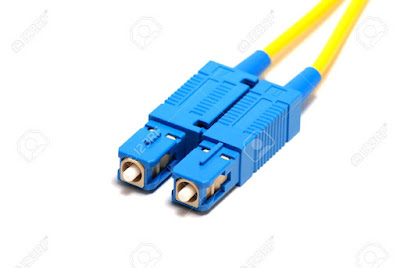Transmission Media - (6)
Transmission Media - 6
Summary on What we have studied on last tutorial :-
- A fiber optic cable consist of a centre pure (silica) glass core not much thicker than a human hair through which light signals pass.
- This cladding is sometimes surrounded by a metal fibers to give extra strength to the cable.
- In a fiber optic cable the electrical signal is converted into appropriate left signals and transmitted through it.
- An emitter sends the signals from one end of the cable and the a light sensor (Photo detector ) senses this signals and then converts into its digital equivalent.
- Two sources of lights : Laser and LED are used for fiber optic cable. In a fiber optic cable, signals can be transmitted in only one direction.
- Able to carry much more information as compared to copper cable
(3.4) Categories of Fiber optic Cable :-
Different types of fiber optic cables are available. The two types of cables usually used are as follows :-
- Single Mode : A type of cable that has only single strand of glass fiber with a thin diameter. This is a 9/125 micrometer fiber cable. The diameter of a core glass is approximately 9 micrometer. Only a single light signal can be transmitted through it. Single mode fiber is more resistant to signal attenuation than multimode fiber. Thus more information can be transmitted over long distances, increasing speed of transmission. Fiber optic cable that use lasers are known as Single mode cable. Single mode fiber optic cable is shown below :
The advantage of single mode fiber optic cable is that data can be transmitted at higher speeds. Single mode fiber optic cable can also transmit data to longer distance i.e. more than one kilometer than multimode fiber optic cable.
single mode fiber optic cable - Multi mode : A type of cable that contains a glass fiber with a larger diameter. Multiple modes of light signals can be propagated through it. This is 62.5/125 micrometer fiber cable. Light signals are transmitted into the fiber using different path and wavelengths. Multi mode fiber transmits the data over short distances as the various modes tend to spread over long distances, resulting in attenuation. Fiber optic cables that uses LEDs are known as Multi mode cable. Multimode fiber optic cable is shown as below:
That advantage of this type of cable is that you can transmit two or more signals using a single cable. The disadvantage of this type of cable is that data cannot be transmitted over a long distances using this cable. Since two or more signals are transmitted over 1 fiber, the transmission speed is less as compared to single mode fiber optic cables. To differentiate between single mode and multimode fiber optic cable is somehow a difficult task. Multi mode cable are used now a days.
multi-mode fiber optic cable
(3.5) Connectors of Fiber Optic cable :-
A connector is a mechanical device that is attached to the fiber optic cable or the light source. A number of connectors are used to connect fiber optic cables. The connectors used with these cable are depend on the different types if light emitting sources such as lasers and LEDs as well as different types of light sensors used. The primary types of connectors used with this cables are as follows :
- Straight tip ( ST) : It was developed by AT&T. A popular connector used with the fiber optic cables and used in Gigabit Ethernet or backbone. Joins individual fibers to optical devices. ST connectors can be used for both single mode and multimode cables. It is easy to insert and remove this connector from the fiber. There are mainly two types of connectors ST and ST-II. It is similar to BNC T connector. ST connectors works well in commercial and office environment. A straight tip connector is shown in the figure below :

ST conenctor - Sub Miniature Type A (SMA) : Defines a connector that uses two individual connectors for each fiber strand. SMA looks similar to ST but uses a threaded outer shell. This type of connection is more rugged, particularly under the stress of vibrations. SMA's are available in two versions namely: 905 and 906. A sub miniature type A connector is shown below :

SMA connector - Subscriber/Standard Connector (SC) : A type of low-cost connector used in 100 Base-FX fiber optic networks and it can be pushed into the device and can be removed by pulling out. It is a one piece component with two slots in it to attach two fibers to send and receive signals. It is similar to the video or audio plug. The SC connector is smaller than ST and SMA connectors and is about the same size as RJ-45 UTP connector. It is difficult to install the SC connector. A Subscriber connector is shown in figure:

Subscriber/Standard Connector
 |
| characteristics of Fiber optic cable |
Thanks for reading !
Have a GOOD DAY !




Thanks for clearing the concept
ReplyDelete